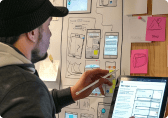
Let’s Talk More About Data Storytelling
“Sometimes, reality is too complex. Stories give it form” – Director, Jean Luc Godard
Quite a few of the posts I have written so far have been on the growing rise and increasing importance of data science. As a natural progression of this theme, I decided to talk about one of the most important aspects of data science – data storytelling.
We all know the importance of data visualisation in the data science narrative. Data visualisation can be equated to Lego blocks. Each of these blocks can be connected together to build an object. Unless these are placed in a certain manner and connected correctly, the said object might not look like as it was intended. Data storytelling is a lot like this. It gives form to the visualisation and helps us see the big picture.
Data storytelling, quite simply, helps us connect the dots that we generate from visualisations. With storytelling, it becomes easier to illustrate a particular point or highlight a particular technique and answer a question ‘completely’. This isn’t a comment on the quality of the visualisation. Two good visualisations independently are not capable enough to answer a question that prompted them. They are also not completely capable of passing an analysis in a real-world business environment. This is because all these independent visualisations have to be viewed in the context of a larger analysis.
The What and Why of Data Storytelling?
All the information that you get in your dashboard, spreadsheets, visualisations, etc. give you the idea of ‘what’ is happening. However, they do not show ‘why’ something is happening. This ‘why’ piece of information is critical when we want to infuse the data advantage into the enterprise and transform the data center into a profit center…a place where all the stakeholders gain access to the relevant data, which is shared in a language and format that makes it easy to digest and implement.
Data storytelling thus can be defined (quite simplistically) as the methodology for communicating information tailored to the needs of the audience complimented with a compelling narrative. Data storytelling is thus one of the most important aspects of data analysis.
The Main Players in Data Storytelling
“We know that data is powerful. But with a good story, it’s unforgettable … executives and managers are being bombarded with dashboards brimming with analytics. They struggle with data-driven decision making because they don’t know the story behind the data.” – Think With Google paper, writer Daniel Waisberg.
We, as humans, are hardwired to share stories. Want to transmit a large amount of information to an audience? Try telling a story. It is the skill of storytelling that has helped us transmit the power of knowledge that has helped us evolve, form cultures as we know them today, and has enabled evolutionary success across many generations.
In today’s context, we have a lot of information lying tucked away in the gargantuan volumes of data available with us. The dawn of the digital era has only made this data more complex and fast-growing. And if we want to make sense of the data, we need to put a human perspective on it. This perspective comes from data storytelling.
And just like in stories, data storytelling has some key characters that make the story interesting and take it ahead.
Data Science – Data science extracts insights and information from data to make it readily available
Visualisations – These insights are then presented in graphs, pie, and line charts, etc. to get an at-a-glance snapshot of data. It explains what happened.
Narrative – A narrative, just like in stories, is the most important aspect of the data story. It uses a language in a format that enables easy comprehension of the full information. It thus becomes the vehicle to convey insights and use the data and visualisations as points of proof and gives voice to the data.
Taking the Story Forward
Data visualisation expert Stephen Few mentioned, “Numbers have an important story to tell. They rely on you to give them a clear and convincing voice.”
To do that, it is essential to have the skills to combine the three elements of data, visualisations, and narrative. When the narrative is coupled with data, it helps you explain what’s happening to the data and the importance of the insight. You also need to add ample commentary and context to appreciate the insight.
By adding visuals to the data, you enlighten the audience – they can now see what they otherwise could not see in the lines, rows, and columns of spreadsheets in the absence of charts or graphs. Combining the narrative, the visualisations, and the data give you the whole story – one that helps you drive change.
Many tell me that they find data storytelling a time-consuming effort. After all, insights and facts should be sufficient enough if they are fleshed out clearly. Revealed insights should be enough to influence the right decisions.
However, the flaw in this argument is that while the insights are logical and comprehensive, they are not influential. That is because people only hear statistics. But they feel stories. And in its memorability, its persuasiveness and its engagement lie the influence of data storytelling.
Data storytelling is quite like regular storytelling. It has to have a beginning, a middle and an end. It has to have a hypothesis. It has to have supporting facts. It has to have a compelling presentation. It also pays to remember that data science tools are core tools that are very valuable that help us find insights and tell these stories.
In Conclusion
Back in the mid-nineteenth century, an obstetrician, Ignaz Semmelweis, discovered that handwashing could save countless lives. However, he couldn’t communicate his findings convincingly to a skeptical medical community. His data was completely ignored. The life-saving idea rejected. Ignaz was also discredited by his colleagues. All this happened because uncovering key insights is one piece of the puzzle. The puzzle is not complete unless these insights are communicated clearly and comprehensively.
Data storytelling is that frontier that you need to scale to effectively mold data into stories. David Libeskind, VP of analytics at consumer financial services, quite aptly says, “While data visualisation tools are effective, the human element to provide context, interpret results, and articulate insights and opportunities is a critical factor to influence key stakeholders and generate a dialogue to drive strategic decisions.”
I couldn’t agree more. The question is, do you?

















